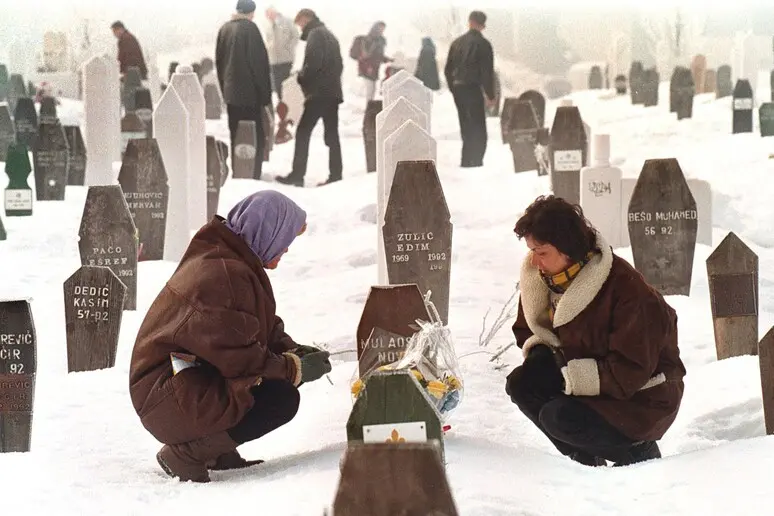They paid to shoot in Sarajevo, "children cost more": an investigation into the "weekend snipers" is underway in Milan.
Italians who financed Bosnian Serb militias for the sheer pleasure of killing residents in the besieged city: thirty years later, the Prosecutor's Office is investigating(Handle)
Per restare aggiornato entra nel nostro canale Whatsapp
They left Italy, paying "huge" sums to Serbian soldiers to participate in the siege of Sarajevo and shoot citizens of the Bosnian capital "for fun" during the war. An investigation is underway in Milan to identify these "war tourists," aiming to identify those who participated in the massacre of over 11,000 people between 1993 and 1995, as reported today by Il Giorno and La Repubblica.
The case—which Il Giornale reported on in July—was opened by prosecutor Alessandro Gobbis on charges of voluntary homicide aggravated by cruelty and despicable motives. Currently, the charges are against unknown persons, stemming from a complaint filed by journalist and writer Ezio Gavazzeni. According to testimonies gathered from across northern Italy, these "weekend snipers," mostly far-right sympathizers with a passion for weapons, gathered in Trieste and were then taken to the hills surrounding Sarajevo, where they could fire on the population of the besieged city after paying Radovan Karadzic's Bosnian Serb militia. The case also contains a report on these "rich foreigners engaged in inhumane activities," submitted to the Milan Prosecutor's Office by former Sarajevo mayor Benjamina Karic.
"What I learned, from a source in Bosnia-Herzegovina, is that Bosnian intelligence at the end of 1993 alerted the local SISMI headquarters to the presence of at least five Italians, who were in the hills surrounding the city, accompanied to shoot civilians ." This is stated in the complaint by writer Ezio Gavazzeni. "My source," explains the writer, assisted by lawyers Nicola Brigida and Guido Salvini, "was part of Bosnian intelligence" and is identified in the document by name and surname . Gavazzeni reports an email exchange from November 2024 with the source, who wrote: "I learned of the phenomenon at the end of 1993 from documents from the Bosnian military security service on the interrogation of a captured Serbian volunteer, who had come to fight on the side of the Serbs in Bosnia and Herzegovina. He testified, it says, that five foreigners traveled with him from Belgrade to Bosnia and Herzegovina (at least three of them were Italian, and one said he was from Milan)." At the time, the former Bosnian 007 recounted, "I was working in the military intelligence service of the Bosnian army. We shared the information with SISMI (now AISI) officials in Sarajevo because there were indications that tourist groups of snipers/hunters were leaving from Trieste." The writer, in the 17-page complaint, states that "one witness reported that among them were Italians: a man from Turin, one from Milan, and the last from Trieste." And again: "One of the Italian snipers identified on the hills above Sarajevo in 1993, the subject of the report to SISMI, was from Milan and the owner of a private clinic specializing in cosmetic surgery."
For now, the investigation only includes the documents submitted by the author of the complaint, dated January 28, and in the coming weeks, prosecutor Alessandro Gobbis, with responsibility for the Carabinieri ROS special operations unit, will have to investigate, possibly interviewing the people indicated by the writer. For now, the writer explains, "these are just 'tips,'" but there was also "a price tag for these killings: children cost more, then men (preferably in uniform and armed), women, and finally old people, who could be killed for free." The writer also refers to the 2022 documentary "Sarajevo Safari" and clarifies that "director Miran Zupanic gave us the passwords to access the restricted viewing of the film on the Al Jazeera website, and I can provide them to the magistrate who requests them." The film also features an anonymous witness. And again: "Some sources speak of Americans, Canadians, and Russians, but also Italians, who were willing to pay to play war." The clients, the former Bosnian 007 said, were "certainly very wealthy people" who could "financially afford such an 'adrenaline-pumping' challenge. " Given the way "everything was organized, the Bosnian intelligence services believed that the Serbian State Security Service was behind it all." And with "the infrastructure of the former Serbian charter and tourism airline Aviogenex." Jovica Stanišić, "convicted of war crimes by the International Criminal Tribunal for the former Yugoslavia, played a key role in this service." According to the complaint, among these "sniper tourists" were also hunting and weapons enthusiasts. And the "hunting cover served to bring the groups to their destination in Belgrade, unsuspecting."
"On more than one occasion, I witnessed people who didn't seem like locals to me because of their clothing, the weapons they carried, the way they were treated, managed, that is, guided by locals. I saw this in Sarajevo on several occasions." This is a passage from the testimony of John Jordan, a former American firefighter who volunteered in the besieged city of Sarajevo in the 1990s, before the International Criminal Court in The Hague in the trial of Bosnian Serb Army commander Ratko Mladic. Passages from this 2007 deposition are also cited in the statement by writer Ezio Gavazzeni to the Milanese prosecutors. "It was clearly evident," the testimony from 18 years ago continues, "that the person guided by men who knew the terrain well was completely unfamiliar with the area, and his clothing and the weapons he was carrying made me think they were tourist shooters." And again: "When a boy shows up with a weapon that seems more suited to wild boar hunting in the Black Forest than to urban combat in the Balkans... When you see him handle it and you realize he's a novice..." Currently, among other things, a photography exhibition entitled 'Shooting in Sarajevo' is underway at the Casa della Memoria in Milan, which commemorates the siege of the city 30 years ago.
(Unioneonline)
